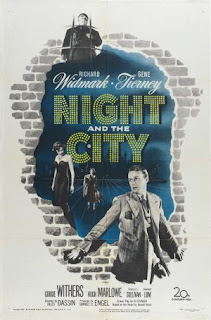Night and the City

My discussion of Night and the City concludes my look at the films of both Richard Widmark and Jules Dassin (as it finally became available after several weeks on Netflix), and it's somehow appropriate, as it may well have been the finest work by both of them.
Released in 1950, it was Dassin's last Hollywood film before being blacklisted. Producer Darryl Zanuck saw the writing on the wall for Dassin, and rushed this film into production, giving him the novel and sending him to London to shoot it, telling him to film the most expensive scenes first so the studio (Fox) would be on the hook. Dassin, several years later, confessed that he never read the book, and was sympathetic to author Gerald Kersch for being angry.
What Dassin came up with instead is the story of Harry Fabian, played by Widmark. Fabian is first seen in the film running from someone, and he hardly ever stops for the rest of the film. He's a hustler, a tout for a "gentleman's" club where his girl, Gene Tierney, is a singer and hostess. She loves him but also enables him, as he is constantly short of money and has one cockeyed scheme after another. A neighbor says that Fabian "is an artist without an art," which can be very dangerous.
One evening Fabian meets a wrestling champion from Greece, who is disgusted by the fakery of the pro-wrestling that goes on, even though his son is the promoter. Fabian gets in good with the old man, and needs 400 pounds to set up as a promoter. The club-owner's wife (played evilly by the vividly-named Googie Withers) wants to leave her overweight, nasty husband (Francis L. Sullivan) so gets Fabian the money if he agrees to get her a license for her own club. Fabian, spinning several plates in the air, connives and schemes to bring off a match without getting snuffed by the rival promoter (played by Herbert Lom, later famous as Inspector Dreyfus in the Pink Panther movies). Inevitably, everything starts to fall apart for Harry, and by the end of the picture he's back running for his life.
This is a brilliant film, but it's not easy to watch. The main characters have few redeeming qualities. Even Tierney, who is lovely and loves Harry, simply serves his needs as if he were a spoiled child. Widmark is amazingly effective as Harry. We can see the wheels spinning his head, calculating his moves, though he seems to be cursed to always coming up short and being behind the eightball.
Another interesting performance is by Stanislaus Zbyszko as the champion wrestler. He was a world champion wrestler, and had a face and body to prove it. Dassin recalls in supplemental materials that he was a very soft-spoken, cultured man and took his one acting job very seriously. There is a crucial fight between him and Mike Mazurki, as The Strangler, that is suspenseful and very well photographed.
Some of the London critics maintained that Dassin's London was not realistic at all, but Dassin maintains that he researched it with the help of those who knew the seamy sides of the town. His research pays off, as the viewer almost wants to take a shower after it's over. So many films from the forties and fifties have been packaged as "noir," even if they don't fit the definition. This, ladies and gentleman, is true noir, and is about a fine an example as you'll find.


Comments
Post a Comment